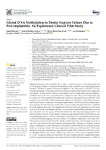Global DNA Methylation in Dental Implant Failure Due to Peri-Implantitis: An Exploratory Clinical Pilot Study

Ver/Abrir
Use este enlace para citar
http://hdl.handle.net/2183/29464
Excepto si se señala otra cosa, la licencia del ítem se describe como Creative Commons Attribution 4.0 International Licence (CC-BY 4.0)
Colecciones
- Investigación (FCS) [1293]
Metadatos
Mostrar el registro completo del ítemTítulo
Global DNA Methylation in Dental Implant Failure Due to Peri-Implantitis: An Exploratory Clinical Pilot StudyAutor(es)
Fecha
2022-01-17Cita bibliográfica
Khouly I, Pardiñas López S, Díaz Prado SM, Ferrantino L, Kalm J, Larsson L, Asa'ad F. Global DNA Methylation in Dental Implant Failure Due to Peri-Implantitis: An Exploratory Clinical Pilot Study. Int J Environ Res Public Health. 2022 Jan 17;19(2):1020.
Resumen
[Abstract] Background: Peri-implantitis (PIT) is highly prevalent in patients with dental implants and is a challenging condition to treat due to the limited outcomes reported for non-surgical and surgical therapies. Therefore, epigenetic therapeutics might be of key importance to treat PIT. However, developing epigenetic therapeutics is based on understanding the relationship between epigenetics and disease. To date, there is still scarce knowledge about the relationship between epigenetic modifications and PIT, which warrants further investigations. Aim: The purpose of this study was to evaluate the level of global DNA methylation associated with implant failure (IF) due to PIT compared to periodontally healthy (PH) patients. Material and Methods: A total of 20 participants were initially enrolled in this pilot, exploratory, single-blinded, cross-sectional clinical human study in two groups: 10 in the PH group and 10 in the IF group. In the participants who have completed the study, gingival tissue and bone samples were harvested from each participant and were used to perform global DNA methylation analysis. The percentage of global DNA methylation (5-mC%) was compared (1) between groups (PH and IF); (2) between the subgroups of gingival tissue and bone separately; (3) in the whole sample, comparing gingival tissue and bone; (4) within groups, comparing gingival tissue and bone. Demographic, periodontal, and peri-implant measurements as well as periodontal staging, were also recorded. All statistical comparisons were made at the 0.05 significance level. Results: Out of the initially enrolled 20 patients, only 19 completed the study and, thus, were included in the final analysis; 10 patients in the PH group and 9 patients in the IF group, contributing to a total of 38 samples. One patient from the IF group was excluded from the study due to systemic disease. The mean implant survival time was 10.8 years (2.17–15.25 years). Intergroup comparison, stratified by group, indicated a similar 5-mC% between the PH and IF groups in both gingival tissue and bone (p = 0.599), only in bone (p = 0.414), and only in gingival tissue (p = 0.744). Intragroup comparison, stratified by the type of sample, indicated a significantly higher 5-mC% in gingival tissue samples compared to bone in both the PH and IF groups (p = 0.001), in the PH group (p = 0.019), and in the IF group (p = 0.009). Conclusions: Within the limitations of this study, higher global DNA methylation levels were found in gingival tissue samples compared to bone, regardless of the study groups. However, similar global DNA methylation levels were observed overall between the IF and PH groups. Yet, differences in the global DNA methylation levels between gingival tissues and bone, regardless of the study group, could reflect a different epigenetic response between various tissues within the same microenvironment. Further studies are necessary to elucidate the present findings and to evaluate the role of epigenetic modifications in IF due to PIT.
Palabras clave
DNA methylation
Epigenomics
Dental implantation
Peri-implantitis
Periodontium
Epigenomics
Dental implantation
Peri-implantitis
Periodontium
Versión del editor
Derechos
Creative Commons Attribution 4.0 International Licence (CC-BY 4.0)
ISSN
1660-4601






